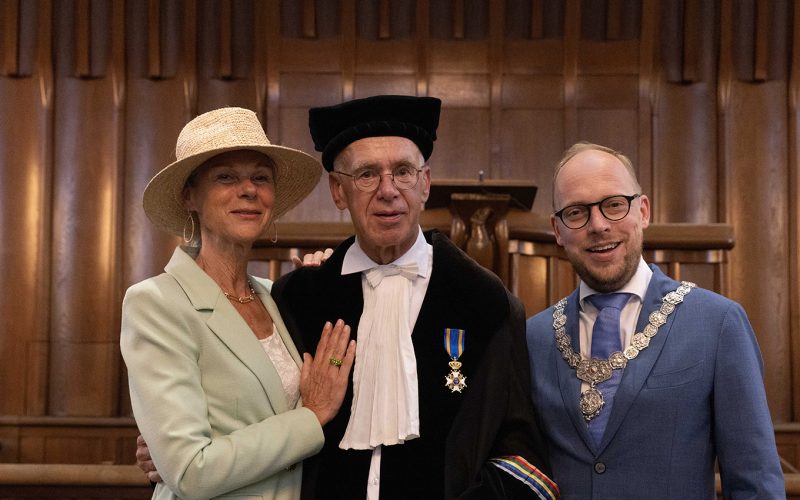After more than 22 years, Pieter Doevendans is saying farewell to UMC Utrecht. As Professor of General Cardiology, he was a true connector between research and clinical care. On Friday, June 20, he delivered his farewell lecture in the Dom Church, themed ‘RonDom Vooruitgang’. At the ceremony, he was appointed Knight in the Order of the Lion of the Netherlands for his exceptional contributions to the field of cardiology. We look back with Pieter on a remarkable career as a cardiologist and researcher.
Pieter decided to study medicine at Leiden University based on the advice of his high school teachers. He initially planned to pursue tropical medicine and worked to prepare for that path but ultimately chose to specialize in cardiology in Maastricht. This decision was partly influenced by the early death of his father at age 41 from a heart attack. “What really appealed to me is that cardiology is a hands-on field. You can truly make a difference for people.” In 2002, Pieter joined UMC Utrecht, where he was appointed professor and later became head of the Department of Cardiology.
Since he started in Utrecht, Pieter has witnessed a complete transformation in the field. This inspired the theme of his farewell lecture: ‘RonDom Verandering’. “Twenty years ago, we were still debating whether you could place a heart valve using a balloon catheter through the groin without surgery,” he recalls. “Now, that’s the standard technique, and care for patients has improved tremendously.” Another example of rapid progress is the development of gene therapy. “At the start of my career, that was unthinkable. Now, we are very close to developing gene therapies that can cure inherited heart diseases.” A third major innovation is the artificial heart. The first patient has already been treated with one. “Artificial hearts may eventually solve the ongoing shortage of donor hearts. I expect we’ll be much further along in five years.”
Throughout his career, Pieter combined clinical work with research. “Depending on the phase, I could devote more or less time to research, but I always kept one day a week free for it. That allowed me to build bridges and translate questions from the lab into clinical practice.” He published more than 900 scientific papers over the course of his career. He played a major role in a long list of breakthroughs, including an organ perfusion system to improve heart transplants, a new treatment for arrhythmias, and advanced imaging technologies for surgery. He also conducted stem cell research, which he holds in high regard: “We can already use a patient’s own stem cells to create heart patches, pieces of heart muscle tissue to repair damage. The ultimate goal is to stimulate the heart to regenerate, so it heals itself.”
Many of these innovations and research successes are rooted in collaboration with researchers and partners. As director of the Netherlands Heart Institute (NLHI), Pieter helped structure nationwide collaboration between cardiologists. “NLHI works with the Dutch Heart Foundation and academic centers through the Dutch CardioVascular Alliance. That synergy is essential and quite unique: we speak with one voice. This helps bring topics to the political agenda and enables us to collaborate internationally as one center.” In addition to his role as director, Pieter also held several management positions, including division head of Heart & Lungs and of the Division of Surgical Specialties. He also founded several companies: Hearteye, Leadpharma, and International Cardio Corporation. As of July 1, Pieter will also step down as director of the NLHI.
Working with students and mentoring them was, according to Pieter, the most rewarding part of his job. He was voted PhD supervisor of the year three times. “Working with students and early-career researchers gives me a huge amount of energy. It’s incredibly valuable to support their growth,” he explains. For example, he organized annual sessions where PhD candidates could pitch wild ideas, a way to practice thinking outside the box. The best idea won a prize. His advice to young researchers: “Follow your heart, and don’t be afraid if results don’t come right away.”
Cycling has been a constant theme throughout Pieter’s career. From intense 500-kilometer rides to raise funds for research, to tandem rides with patients. “Riding a tandem bike means working together to move forward, a great symbol of the doctor-patient relationship. You need each other. We’ve ridden tandem tours with patients and colleagues seven times, raising significant funds for research.”
Pieter’s appointment as Knight in the Order of the Lion of the Netherlands is the crowning achievement of a distinguished career. Utrecht’s Deputy Mayor Eelco Eerenberg presented this royal honor during the farewell ceremony. But despite his formal retirement, Pieter will still be a familiar face at UMC Utrecht. He continues to supervise ten PhD candidates and will devote one day a week to research. “I no longer do clinical work, but I will continue supporting patients and patient organizations.” Pieter will also serve on UMC Utrecht’s works council in the coming year. “And of course, I’ll keep enjoying long bike rides. But after a lifetime of hard work, it’s time for a bit more peace.”
